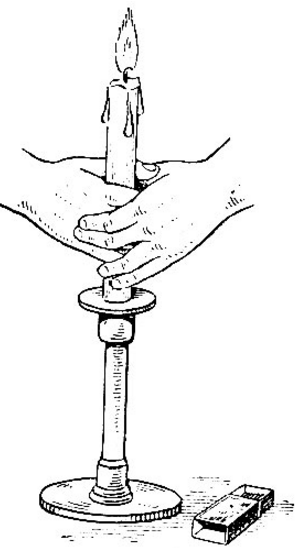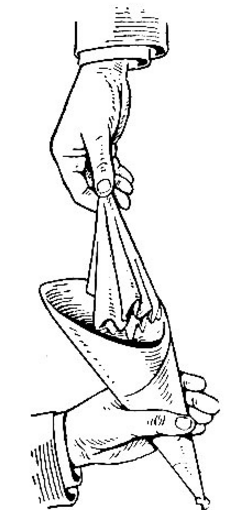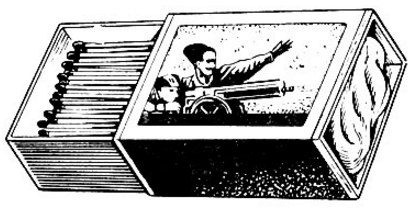
|
|
EFFECTIVE FOCUSES AND THEIR CLUES Traveling scarf. Focus Secret
Directory / Spectacular tricks and their clues Focus Description: The performer asks the audience for a small colored silk handkerchief. Spectators offer, but none of the handkerchiefs fit. - Well, it doesn't matter, - says the magician, - I myself will be able to get a handkerchief in some "magic" way. Quickly rolling up his sleeves to the elbow, he explains: - I did this so that you would not think that I would take the handkerchief out of my sleeve. As you can see, I have absolutely nothing in my hands. He takes a candlestick with a candle, puts it on a small table and puts matches here. He says that the easiest way to get a handkerchief is from a candle flame. Lights a candle and, clasping it with the fingers of both hands, moves them up to the flame (Fig. 58).
- Ready! - But as soon as he brings his hands to the flame, the candle goes out. - The candle went out at the wrong time! Let's try again. He takes the matches again and lights the candle again, but it goes out again. The performer, nervous, lights the candle for the third time, discarding the matches, runs his hands over the candle - and suddenly the tip of the handkerchief appears from the flame itself. The illusionist takes the handkerchief with his right hand and, showing it to the audience, says: - As you can see, the handkerchief itself appeared. - Extinguishes the candle and takes the wand. - I can't do without a "magic" wand. - He takes a quarter of a newspaper and rolls up a pound. He asks for two spectators. One of them gives a bag. Rolls up the second pound and gives it to the second viewer to hold. Then he talks about the magical power of the "magic" wand. Taking a handkerchief, he puts it in a bag, located at the first viewer, carefully straightens the handkerchief with a stick and tucks it inside. Then he wraps the edges of the bag and makes several "magic" passes in the direction from the first to the second viewer. - Once! Two! Three! Ready! The handkerchief flew over, - the performer says, referring to the first viewer. - Expand. The handkerchief disappeared, and you, - referring to the second viewer, - appeared. Expand and you. - Spectators deploy bags and ... oh horror! The first one has a double bag and from the "pocket" you can see the tip of the handkerchief that is hidden there. The illusionist quickly takes the bundle from the first spectator and, turning it to the other side, shows: - See? Disappeared! - And at this time he himself fills the handkerchief inside the bag from its back side. Moves to the second viewer. He unpacks the bag, but there is no handkerchief. The performer looks reproachfully and whispers: - Styopa, where is the handkerchief? The assistant sticks his head out of the wings and quietly answers: - I forgot to put it. The performer is clearly embarrassed, and the assistant, having entered the stage, approaches the first spectator, takes out a handkerchief from the "secret pocket" of the pounder (Fig. 59) and gives it to the embarrassed magician.
- Well. Only those who do nothing do not make mistakes. Let's try everything first. The illusionist again rolls up two pounds and gives them to the audience to hold. With a stick, he spreads the bag at the first viewer and puts a handkerchief in it (Fig. 60), and it is noticeable that he pushes the handkerchief into the pocket of the bag. Having wrapped the bundle, he moves on to the second one and, having corrected the teak pack with a stick, wraps it up in the same way. Then he makes passes again.
- Once! Two! Three! Ready! Unfold the sachets. Spectators deploy: the first handkerchief disappeared, and the second appeared. The bags are torn apart, but there is nothing in them. - I hope that now you all understand how this is done? - says the performer. Props: Three identical silk handkerchiefs. Wand for the disappearance and appearance of scarves. Candlestick with a candle. Box of matches. Several newspapers for pounders. The stick has small protrusions - sides at both ends. Rice. 69 gives a clear idea of the structure of the stick: A - its general appearance; B - a pin that goes inside; B - a cork with a hook that enters the other end of the tube; G - a stick in a section. The pin is designed to "take" a silk handkerchief inside the stick, and the cork with a hook is designed to "give" a handkerchief pre-loaded into the tube (a stick with two handkerchiefs inside is shown in Fig. 69, E).
Now that we are clear on the meaning of the wand, we can move on to making it. If you can find a thin-walled brass tube with a diameter of 18 or 20 mm, this will make your task much easier. You can carefully solder a tube of the specified diameter from tin yourself. The soldering must be very clean so that no seam is visible. Carefully clean the edges of the tube inside, the handkerchief should not touch them. Then you grind two metal plugs 6 or 8 mm long and with a diameter equal to the inner diameter of the tube. Plugs should fit easily into the tube and hold well in it. Cut a piece 185 mm long from a bicycle spoke, sharpen one end and solder a drilled ball at a distance of 5 mm from the tip. In traffic jams, drill a hole with a diameter equal to the thickness of the knitting needle and a height of 5-7 mm. Then, from the knitting needle, cut the second piece 20 mm long and sharpen one end and bend it with a hook (Fig. 69, E). Now both segments of the knitting needle - the pin and the hook - are inserted into the plugs and firmly sealed "tightly". It would be nice to make a thread on the pin and hook and screw them inside the plugs. The ejection mechanism consists of three parts (Fig. 70, A): spring P made of steel wire with a diameter of 15 mm; two circles K and K1; they can be picked up from old copper coins.
Circle Kg exactly the same diameter as the inner diameter of the tube. He must enter into it with great friction. Solder it "tightly". In the center of the circle, drill a hole with a diameter of 1 mm and firmly solder the spring P, about 15-18 cm long, which will eject the handkerchief. Attach the second circle, K, in the same way to its second end; in the center of it from below, when soldering a small ring, to which tie a strong nylon thread H or fishing line. Pass its second end through the entire spring and through the center of the hole in the K1 circle, where it is tied in a knot after both circles are 10 cm apart. The thread will not allow the mug K to jump out of the tube when the apparatus is ready. Insert the manufactured mechanism into the tube and press the circle K1 with a stick until the circle K is equal to the edge of the tube. Now it remains only firmly when making circle K1. To facilitate this operation, the tube bent from tin is not soldered immediately, but first the ejection mechanism is inserted inside, it is carefully soldered, and then the seam is already soldered. If you use a finished tube, then make circle K1 thicker. After inserting the ejector into place, hit the tube with a core where the circle is. After making three or four strokes, you will firmly fix the circle. Then insert the cork with the hook into the stick, this will compress the spring and give place to the hook. From the second end, insert a cork with a pin - and our wand will be ready. Make some preparations before your session. After cutting the newspaper in half, fold one sheet of it in half (in width), and glue those inside along the edges. Thus, you get a double quarter of the newspaper (Fig. 71). In the upper right corner of the top sheet, make a cut of such a size that a handkerchief can enter it.
Take the resulting double quarter with your left hand by the lower right edge of B, put four fingers of your left hand on the newspaper, and stick your thumb under it. Then, with your right hand, take the newspaper at point B with your thumb above, with the rest below; turning your left hand inward, make a small bag, twist its bottom at point B - and the bag is ready. You need to learn how to do it clearly and quickly. You need to have several such quarters. Focus secret: Before the performance, the stick is charged with a handkerchief from the end where the cork with a hook is located. The second handkerchief is rolled up as compactly as possible and placed in a box of matches (Fig. 72). Matches are half pulled out of the box, and a handkerchief is loaded at the opposite end. It is clear that the matches are placed so that the audience does not see the handkerchief.
During the performance of this trick, the performer lights a candle several times so that the audience does not pay attention to the matches. When the illusionist lights the candle for the third time, he closes the box (Fig. 73) and thereby pushes the handkerchief out of the box into the palm of his left hand, where he hides it. Then, running his hand over the candle, the magician pulls out the handkerchief by the end with his right hand so that the audience has the impression that the handkerchief is being removed from the flame of the candle.
After rolling up the first bag, you put it on a stick and, turning it upside down, show the audience that it is empty. Turning the bag over again, adjusting it, quietly open the incision valve and put the handkerchief between the walls of the bag, leaving the tip of the handkerchief slightly protruding from the incision. At the same time, do not forget to correct the handkerchief with a stick inside the bundle all the time. Then everything goes according to the description: roll up two new pounds, turn the first one upside down again, put it on a stick and, turning it back to its previous position, take the sharp end of the bag with your left hand. Then, quickly holding the cork of the rod, leave it unnoticed in the middle of the pounder, and take out the stick. Put the handkerchief in the middle on the tip of the rod, straighten it with a stick and discreetly insert it into the tube. Then, taking the stick out of the bag, pretend that you are pushing the handkerchief into the pocket of the pounder with it. Approach the second viewer, turn the bag over in the same way, inserting a stick into it, and with your left hand grab the cork through the wall of the pounder from the "giving" end. Then, turning the bag over, take out the wand, leaving the handkerchief unnoticed in the bundle. With a certain skill, adjusting with a stick, you can remove the handkerchief from the hook, and put the cork in its original place. If you do not achieve proper dexterity, do not be embarrassed: removing the handkerchief from the second pound, you can squeeze the cork into the handkerchief so that the viewer does not see it. The more you show confusion at your "failure" with the first disappearance of the handkerchief, the greater will be the success with its second disappearance. Author: Vadimov A.A.
▪ Manipulation is the basis of illusion art. Preparatory work on tricks. exercise
Air trap for insects
01.05.2024 The threat of space debris to the Earth's magnetic field
01.05.2024 Solidification of bulk substances
30.04.2024
▪ Portable printer LG Pocket Printer (PD261) ▪ The cost of automotive electronics is on the rise ▪ The most accurate optical clock
▪ section of the site Standard instructions for labor protection (TOI). Selection of articles ▪ article by Isadora Duncan. Famous aphorisms ▪ article What are evergreens? Detailed answer ▪ article Travel organizer. Job description ▪ article Cable insulation. Encyclopedia of radio electronics and electrical engineering ▪ article Increasing scarf. Focus secret
Home page | Library | Articles | Website map | Site Reviews www.diagram.com.ua |






 Arabic
Arabic Bengali
Bengali Chinese
Chinese English
English French
French German
German Hebrew
Hebrew Hindi
Hindi Italian
Italian Japanese
Japanese Korean
Korean Malay
Malay Polish
Polish Portuguese
Portuguese Spanish
Spanish Turkish
Turkish Ukrainian
Ukrainian Vietnamese
Vietnamese









 See other articles Section
See other articles Section 